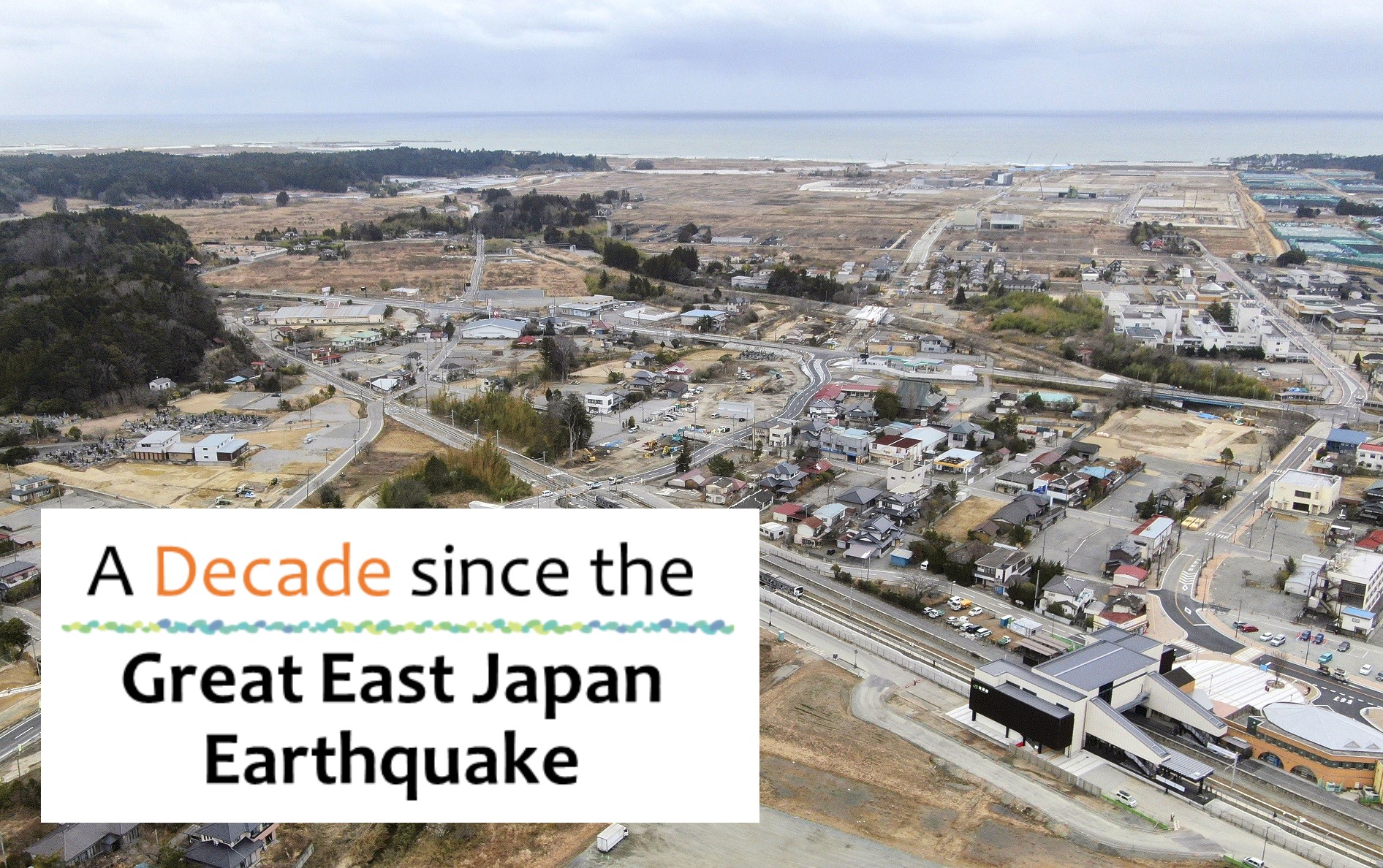
- Article
- Abandoned Land
Post-Tsunami Reconstruction and Lapses in Land Ownership Records
March 15, 2021
Plans to rebuild affected areas were seriously sidetracked by parcels of land whose owners could not be tracked down. Legal and other reforms over the past decade have helped mitigate the problem, but more work is needed to prevent passing on a negative legacy to future generations.
* * *
The unfinished task of rebuilding areas decimated by the March 2011 Great East Japan Earthquake has shed new light on issues that predate the disaster, notably the challenge of keeping outlying regions economically viable in the light of Japan’s dwindling population.
One bottleneck to rebuilding communities on higher ground or clearing plots for new uses has been the difficulty of identifying landowners due to public records that are incomplete. This is because the real property registry—the basic source of information on land ownership—is a voluntary system.
Ownership becomes difficult to ascertain when the inheritors of a parcel of land fail to register their property. Especially in rural areas where real estate values are low, people are less motivated to expend the time and money involved in transferring the title, and the land often remains registered in the name of the deceased.
Iwate Prefecture found that ownership records were incomplete for some 30% of the 13,000 plots that it had surveyed for reconstruction projects as of the end of November 2013. Besides the failure to register inherited real estate, the title was sometimes shared by several people but listed the name and address of only one owner. Mortgage claims valued at less than \100 dating to the early twentieth century were also found, requiring a time-consuming process of canceling such claims. Many relocation projects in Iwate, Miyagi, and Fukushima hit a snag, with only 48% of planned land acquisitions being completed as of September 2013, according to a 2016 report by the Reconstruction Agency.
It was not until April 2014, three years after the tsunami, that the national government amended the law governing Tohoku earthquake special economic zones to ease land appropriation procedures.
Recognition as a Grave Policy Issue
Most members of the public learned about land of unknown ownership in the wake of the 2011 earthquake and tsunami, but the problem itself is not new. Against the backdrop of Japan’s aging and shrinking population, it had long stymied efforts to make active use of abandoned farmland and implement public works projects.
Abandoned and unclaimed homes, similarly, became a headache for many communities in the late 2010s, leading to a recognition that at the root of both problems was a flawed system of personal inheritance. A report published in June 2017 by a group headed by former Iwate Governor and Internal Affairs and Communications Minister Hiroya Masuda set off alarm bells, moreover, when it stated that the combined area of unclaimed land in Japan was an estimated 4.1 million hectares—more than the entire area of the island of Kyushu.
Recognizing the gravity of the situation, the government of Shinzo Abe set to work formulating countermeasures, outlining agendas in its 2017 Basic Policy on Economic and Fiscal Management and Reform to encourage related ministries to jointly review pertaining laws and facilitate the registration of inherited property and proper use of land.
Recent Developments
Japan’s land policy since the late nineteenth century has been built on the premise of population growth and land being a marketable asset. Until quite recently, the focus has been on containing market excesses, such as overdevelopment during the high-growth years or speculation in a bubble economy. The problems we are seeing today require a different approach, since—with a shrinking population and falling property values—they are unlikely to be resolved through the market mechanism. The basic tenets and laws covering land policy need to be thoroughly revised.
In January 2018, the government established a meeting of relevant cabinet ministers to formulate a basic plan and timetable to address this issue. Among the steps taken so far, the biggest policy milestones have been (1) the enactment of a special measures law to facilitate the use of land of unknown ownership, (2) the revision of the Basic Land Act, and (3) the amendment of the Civil Code and the Real Property Registration Act.
(1) A Special Measures Law on the Utilization of Unclaimed Land
The first step taken in specifically addressing the problem of unknown owners was the June 2018 enactment of a special measures law granting local entities—including private businesses—the right to use vacant and unclaimed land parcels for public purposes for a period of up to 10 years. While stringent conditions must be met, the land may be used for a range of purposes, such as parks and shops. The law will allow, for example, convenience stores to open temporarily on unclaimed land following a natural disaster. It also introduced measures to simplify the procedures for expropriating abandoned land, broaden the set of records that can be searched to identify owners, and encourage heirs to transfer the title.
(2) Revision of the Basic Land Act
Another milestone was the March 2020 revision of the Basic Land Act. Originally enacted in 1989 at the height of the asset bubble, it had become full of anachronisms due to subsequent population decline, rise in abandoned fields and homes, and the prevalence of natural disasters.
Aimed at checking the expansion of unclaimed land and preventing the disruption of community life following disasters like the March 2011 earthquake, the revision redefined the purpose of the law, calling not only for proper land use but also for appropriate management. It revised the responsibilities of the national and local governments and called on landowners to register their claims and clarify boundaries. It also stipulated the drafting (by the cabinet) of a basic land policy, thus establishing the foundations of a revamped land ownership system.
(3) Revision of the Civil Code and the Real Property Registration Act
Closely associated with the missing landowner dilemma are the legal rights and obligations of individuals, notably those regarding inheritance and joint ownership. Rectifying the problem thus requires fundamental legal reforms, including amendments to the Civil Code and the Real Property Registration Act. With this in mind, a task force (chaired by Akio Yamanome of the Waseda University Graduate School of Law) was set up in the Legislative Council of the Ministry of Justice in February 2019 to deliberate on such reforms, and the group’s recommendations were submitted to the minister of justice in February 2021.
The report prescribes making the registration of inherited property compulsory and simplifying registration procedures. It also calls for new systems to enable heirs to transfer the title to the national treasury, to allow the appointment an estate administrator specifically for abandoned land, and to permit the use of land with the consent only of known co-heirs. Other measures include a review of the inheritance system to expedite the division of property and clarification of the provisions covering the use of neighboring lands when installing gas, electricity, and other utilities. A bill based on the recommendations was approved by the Cabinet on March 5 and is expected to be enacted during the current session of the Diet.
Future Issues
Substantial progress has been made over the past decade since the problem of unclaimed land was brought to the nation’s attention in the wake of the Great East Japan Earthquake. But more work is needed, particularly in preventing the issue from growing in the future.
As I have described above, there is now recourse to the temporary utilization of land of unknown ownership, and additional reforms will facilitate the management of such land. But these mechanisms often entail cumbersome procedures and substantial initial investment. These represent costs for the community—and a burden for future generations—that could have been avoided had land been properly managed in the first place. Neglected land, in other words, is a negative legacy we are leaving behind to our children.
Our priority going forward should be to prevent the problem from growing any bigger so as not to burden the generations to come. This will require raising awareness and fostering a common understanding of the problem so that landowners, communities, local authorities, and the national government can work together to achieve appropriate land use and management.
Japan’s land policy is at a crossroads. The measures introduced in the decade since the 2011 earthquake and tsunami must be fully implemented and further reinforced by all concerned to avoid repeating the difficulties experienced by local communities in the reconstruction of disaster-stricken areas.

